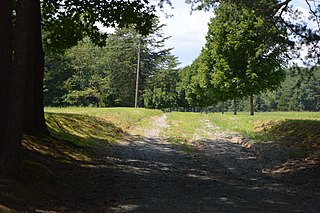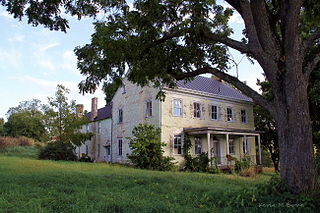
Berkeley Plantation, one of the first plantations in America, comprises about 1,000 acres (400 ha) on the banks of the James River on State Route 5 in Charles City County, Virginia. Berkeley Plantation was originally called Berkeley Hundred, named after the Berkeley Company of England. In 1726, it became the ancestral home of the Harrison family of Virginia, after Benjamin Harrison IV located there and built one of the first three-story brick mansions in Virginia. It is the home to two presidents of the United States: William Henry Harrison, and his grandson Benjamin Harrison. It is now a museum property, open to the public.

Mount Airy, near Warsaw in Richmond County, Virginia, is the first neo-Palladian villa mid-Georgian plantation house built in the United States. It was constructed in 1764 for Colonel John Tayloe II, perhaps the richest Virginia planter of his generation, upon the burning of his family's older house. John Ariss is the attributed architect and builder. Tayloe's daughter, Rebecca and her husband Francis Lightfoot Lee, one of the only pair of brothers to sign the Declaration of Independence are buried on the estate, as are many other Tayloes. Before the American Civil War, Mount Airy was a prominent racing horse stud farm, as well as the headquarters of about 10-12 separate but interdependent slave plantations along the Rappahannock River. Mount Airy is listed on the National Register of Historic Places as a National Historic Landmark as well as on the Virginia Landmarks Register and is still privately owned by Tayloe's descendants.

Lower Brandon Plantation is located on the south shore of the James River in present-day Prince George County, Virginia.

Piney Grove at Southall's Plantation is a property listed on the National Register of Historic Places in Holdcroft, Charles City County, Virginia. The scale and character of the collection of domestic architecture at this site recalls the vernacular architectural traditions of the eighteenth, nineteenth and twentieth centuries along the James River.

The Belair Mansion, located in the historic Collington area and in Bowie, Maryland, United States, built c. 1745, is the Georgian style plantation house of Provincial Governor of Maryland, Samuel Ogle. Later home to another Maryland governor, the mansion is listed on the National Register of Historic Places.

Belmont Manor House, formally known as Belmont Plantation, is a two-story, five-part Federal mansion in Loudoun County, Virginia, United States, built between the years of 1799–1802 by Ludwell Lee (1760–1836), son of Richard Henry Lee. The land surrounding the mansion, the Belmont property, was handed down to his first wife, Flora Lee, from their grandfather, Thomas Lee.

Huntley, also known as Historic Huntley or Huntley Hall is an early 19th-century Federal-style villa and farm in the Hybla Valley area of Fairfax County, Virginia. The house sits on a hill overlooking Huntley Meadows Park to the south. The estate is best known as the country residence of Thomson Francis Mason, grandson of George Mason of nearby Gunston Hall. It is listed on the National Register of Historic Places (NRHP), the Virginia Landmarks Register (VLR), and the Fairfax County Inventory of Historic Sites.

Benjamin Harrison IV was a colonial American planter, politician, and member of the Virginia House of Burgesses. He was the son of Benjamin Harrison III and the father of Benjamin Harrison V, who was a signer of the Declaration of Independence and the fifth governor of Virginia. Harrison built the homestead of Berkeley Plantation, which is believed to be the oldest three-story brick mansion in Virginia and is the ancestral home to two presidents: his grandson William Henry Harrison, and his great-great-grandson Benjamin Harrison. The Harrison family and the Carter family were both powerful families in Virginia, and they were united when Harrison married Anne Carter, the daughter of Robert "King" Carter. His family also forged ties to the Randolph family, as four of his children married four grandchildren of William Randolph I.
Yale is an unincorporated community in rural Sussex County, Virginia, United States. Its ZIP code is 23897.

The Wigwam is a landmark home, of Cape Cod style, built in 1790, close to the Appomattox River near Lodore on Rt. 637, in Amelia County, Virginia. Governor William Branch Giles (1762-1830) built the house and made it his home until his death, and it later became a home for the Harrison family.

Bellwood, also known at various times over the past two centuries as Sheffields, New Oxford, Auburn Chase, and currently as Defense Supply Center Richmond Officers' Club-Building 42, is a historic plantation house located south of Richmond in Chesterfield County, Virginia.

Rose Bower is a historic farm complex located at Stoney Creek, Dinwiddie County, Virginia. The first building on the property is the 1+1⁄2-story kitchen built about 1818 as the primary dwelling. The main dwelling was built in 1826 during the Federal period. It is a two-story, frame, hall-parlor-plan house with a 1+1⁄2-story rear ell. Also on the property are a contributing early well cover, smokehouse, and the Rose family cemetery.

Duke House, also known as Little River Farm, is a historic home located at Bumpass, Louisa County, Virginia. It was built about 1790, and is a 1+1⁄2-story, frame dwelling sheathed with beaded weatherboards with an asymmetrical façade and double-shouldered exterior-end brick chimneys. It has a traditional single-pile, central-passage plan. A wing was added to the west end of the house during the first quarter of the 20th century. Also on the property are a contributing frame dependency and family cemetery.

Spring Bank, also known as Ravenscroft and Magnolia Grove, is a historic plantation house located near Lunenburg, Lunenburg County, Virginia. It was built about 1793, and is a five-part Palladian plan frame dwelling in the Late Georgian style. It is composed of a two-story, three-bay center block flanked by one-story, one-bay, hipped roof wings with one-story, one-bay shed-roofed wings at the ends. Also on the property are the contributing smokehouse, a log slave quarter, and frame tobacco barn, and the remains of late-18th or early-19th century dependencies, including a kitchen/laundry, ice house, spring house, and a dam. Also located on the property are a family cemetery and two other burial grounds. It was built by John Stark Ravenscroft (1772–1830), who became the first Bishop of the Episcopal Diocese of North Carolina, serving from 1823 to 1830.

Isaac Spitler House is a historic home and farm complex located near Luray, Page County, Virginia. The farmhouse was built in 1826, and is a two-story, brick dwelling with a gable roof. A wing was added in 1857 to create an L-shaped building. Located on the property are the contributing remains of a double-unit stone outbuilding which sheltered and sustained the original settlers and two succeeding generations; chimney and remains of a log building; stone wellhouse and dairy; large vernacular Switzer or Swisher barn dated to the 1750s; combination wagon shed and corn crib; a set of stone steps which were used to assist persons in mounting horses and getting into wagons; two eight-foot-high stone gateposts; and a small family cemetery containing nine graves.

Locust Hill is a historic home and farm complex located near Hurt, Pittsylvania County, Virginia. The house was built in two sections with the main section built in 1861, and expanded with a three-story rear ell in 1930. The original section is a 2+1⁄2-story, three-bay, frame dwelling in the Swiss Gothic style. It has a steeply pitched gable roof that incorporates two central chimneys and four gable ends decorated in ornamental bargeboard. Also on the property are a number of contributing resources including a tavern, a servants' quarter, a kitchen, an icehouse, a chicken house, a smoke house, a dairy, a servants' quarter, a caretaker's house, a grist mill, a dam, a family cemetery, and the ruins of an 18th-century house.

Lincoln Homestead and Cemetery, also known as the Jacob Lincoln House, is a historic home and cemetery located near Broadway, Rockingham County, Virginia. It was built in two sections. The main section was built about 1800, and is a two-story, five-bay, brick structure with a side-gable roof. It features an elaborate wooden cornice with Wall-of-Troy molding, corbels and dentils, and a Federal style doorway. The two-story brick rear ell was built in 1849 and joined to the main house in the early-1900s. Located on the property is the Lincoln family cemetery in which are buried five generations of the family, as well as Queenie, a woman who was enslaved by the Lincoln family, and "Virginia John" Lincoln, great-grandfather of Abraham Lincoln.

Maiden Spring is a historic home and farm complex and national historic district located at Pounding Mill, Tazewell County, Virginia. The district encompasses eight contributing buildings, two contributing sites, and one contributing structure. The main house consists of a large two-story, five-bay, frame, central-passage-plan dwelling with an earlier frame dwelling, incorporated as an ell. Also on the property are the contributing meat house, slave house, summer kitchen, horse barn, the stock barn, the hen house, the granary / corn crib, the source of Maiden Spring, the cemetery, and the schoolhouse. It was the home of 19th-century congressman, magistrate and judge Rees Bowen (1809–1879) and his son, Henry (1841-1915), also a congressman. During the American Civil War, Confederate Army troops camped on the Maiden Spring Farm.
Leesylvania was a plantation and historic home in Prince William County, Virginia, now part of Leesylvania State Park. During the 18th century, it was the home of Henry Lee II, his family and numerous slaves, and known for its productive land and especially the quality of its tobacco. Lee's sons Henry "Light-Horse Harry" Lee, Richard Bland Lee and Charles Lee, held prominent positions in Virginia during the American Revolutionary War and early federal government.




















